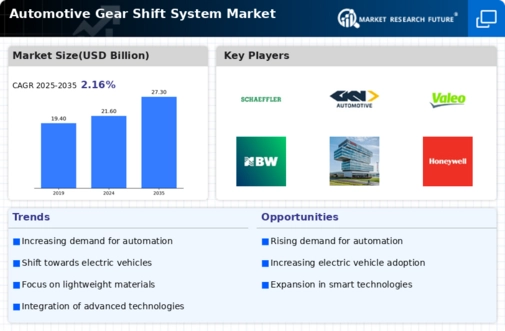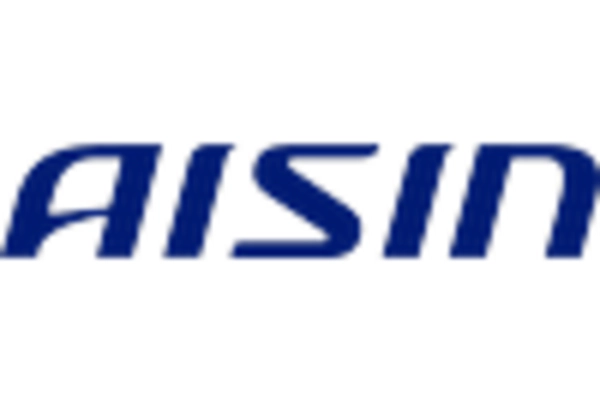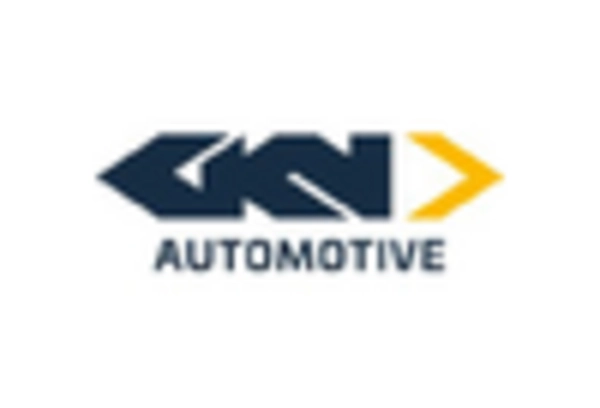Growth of Electric and Hybrid Vehicles
The Automotive Gear Shift System Market is witnessing a transformation due to the rapid growth of electric and hybrid vehicles. These vehicles often utilize unique gear shift systems that differ from traditional internal combustion engines. The increasing adoption of electric vehicles (EVs) is expected to propel the market for specialized gear shift systems designed for optimal performance and efficiency. Reports indicate that the electric vehicle market is anticipated to reach a valuation of over 800 billion by 2027, which will likely necessitate advancements in gear shift technologies to accommodate the specific requirements of EVs. This shift presents a substantial opportunity for manufacturers to innovate and capture a larger market share.
Regulatory Push for Emission Reductions
The Automotive Gear Shift System Market is being shaped by stringent regulatory frameworks aimed at reducing vehicle emissions. Governments worldwide are implementing policies that encourage the adoption of cleaner technologies, which in turn influences the design and functionality of gear shift systems. As manufacturers strive to comply with these regulations, there is a growing emphasis on developing gear shift systems that optimize fuel efficiency and reduce emissions. The market is likely to see an increase in demand for innovative solutions that align with these regulatory requirements. This regulatory push not only drives technological advancements but also creates opportunities for manufacturers to differentiate their products in a competitive landscape.
Technological Advancements in Gear Shift Mechanisms
The Automotive Gear Shift System Market is significantly influenced by ongoing technological advancements in gear shift mechanisms. Innovations such as dual-clutch transmissions and continuously variable transmissions (CVTs) are becoming increasingly prevalent, offering improved efficiency and performance. These advancements not only enhance the driving experience but also contribute to better fuel economy, which is a critical factor for consumers today. The market for these advanced gear shift systems is projected to grow, with estimates suggesting a rise in demand for automated systems that provide smoother transitions and greater control. As manufacturers continue to invest in research and development, the landscape of gear shift technologies is likely to evolve, further driving market growth.
Rising Demand for Advanced Driver Assistance Systems
The Automotive Gear Shift System Market is experiencing a notable surge in demand for advanced driver assistance systems (ADAS). These systems enhance vehicle safety and performance, leading to a growing preference for automatic and semi-automatic gear shift systems. As consumers increasingly prioritize safety features, manufacturers are compelled to innovate and integrate sophisticated gear shift technologies. The market for ADAS is projected to grow significantly, with estimates suggesting a compound annual growth rate of over 20% in the coming years. This trend indicates a shift towards more automated driving experiences, thereby driving the demand for advanced gear shift systems that can seamlessly integrate with these technologies.
Increasing Consumer Preference for Automatic Transmissions
The Automotive Gear Shift System Market is experiencing a shift in consumer preferences, with a marked increase in the demand for automatic transmissions. This trend is largely driven by the convenience and ease of use that automatic systems offer, particularly in urban environments. Data indicates that automatic transmission vehicles account for over 70% of new car sales in many regions, reflecting a significant consumer inclination towards these systems. As a result, manufacturers are focusing on developing more efficient and reliable automatic gear shift systems to meet this growing demand. This shift not only enhances the driving experience but also positions manufacturers to capitalize on the expanding market for automatic transmissions.


















Leave a Comment